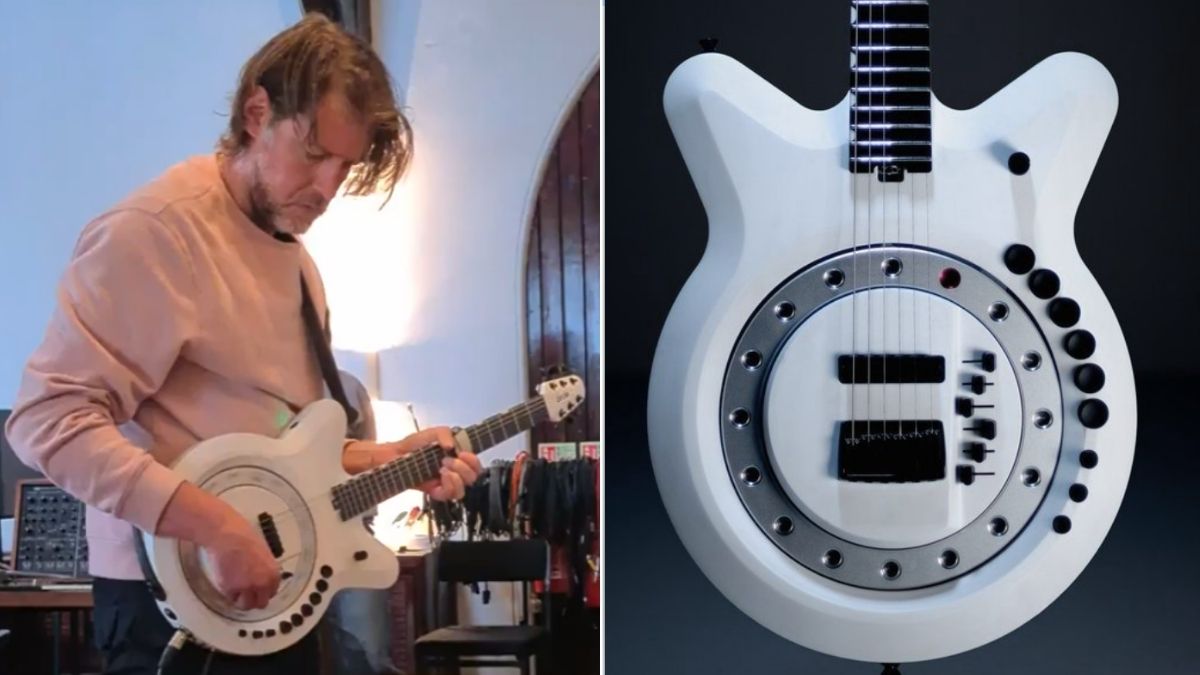Avenged Sevenfold on Developing Rhythm Guitar Skills

In this classic Guitar World lesson, Avenged Sevenfold guitarists Synyster Gates and Zacky Vengeance show you their most trusted dual-guitar techniques. This week: developing your rhythm guitar skills.
ZACKY VENGEANCE: I’ve been influenced by all kinds of different music. As primarily a rhythm player, I’ve come to understand the importance of rhythm guitar. Some players don’t appreciate how important rhythm guitar is and how a good rhythm guitarist will hold everything together. I’ve had the chance to watch Metallica’s James Hetfield from the side of the stage night after night, listening to his monitors, and his playing is so perfect. Slash is an amazing lead guitarist, but when you listen to his rhythm playing you can hear how he pulls everything together with such a great feel, which is the most important thing.
Rhythm guitar is such an important aspect of playing in any band, because good rhythm will mesh everything together. That’s what we try to do in Avenged Sevenfold.
SYNYSTER GATES: When I joined this band, I couldn’t play rhythm guitar worth a shit! I had to practice rhythm guitar, and it was a totally different discipline from soloing; when you’re used to noodling all the time, it’s hard to get in the mindset of working strictly on rhythm. Zacky and I helped each other by mixing and matching elements of our playing styles. In the process, we kind of became hybrids of one another. We started listening to the groove much more, instead of thinking like a bunch of snobby guitar geeks.
VENGEANCE: A great way to get your rhythm playing together is to work with a drummer, preferably someone that has a good groove and plays solidly in time.
GATES: Playing with a good drummer, like the Rev, makes our lives so much easier. It’s impossible to play with a bad drummer. We’ve been playing with the Rev practically our whole lives, and he’s always had a great groove. Even when he was developing his chops, his groove was always there. That made it easy for us to lay down our parts, because we didn’t have to worry that we would be out of time. The groove has always felt natural for us because he’s so tight.
Plus, playing with a great drummer provides for a much more enjoyable experience. We can lay back and play a great show for ourselves and our fans, without having to look back at the dickhead that keeps ruining the song.
All the latest guitar news, interviews, lessons, reviews, deals and more, direct to your inbox!
VENGEANCE: The most important aspect of rhythm guitar is to have control of the strumming hand. Palm muting [resting the edge of the pick-hand palm across the strings at the bridge] is a very important part of my rhythm guitar style. You can do so much with just the two lowest strings, like this [FIGURE 1]: using drop-D tuning [the sixth string is tuned down one whole step from E to D], I’m using the open low D as a palm-muted pedal tone while playing a D minor-type melody on the A string. I’m using all downstrokes, and the palm-muted sixth string provides a percussive element This is a simple riff, and it’s a good one to use to build up speed, strength and stamina with the pick hand.
The goal is to tighten up the rhythm of the downstrokes. This exercise [FIGURE 2] forces you to work on playing evenly picked, palm-muted eighth notes on the sixth string, alternating with a melodic line on the fifth string. Be sure to use all four fret-hand fingers when playing this riff so you can build up the strength and independence you’ll need to shred like Synyster does.
When I first started to play, I used downstrokes all the time—very punk rock. It wasn’t until I started working with Synyster that I began to get my alternate picking together. I recommend alternate picking in order to build up speed, but being able to use downpicking for fast rhythm parts is essential, too. Working on both techniques will help develop speed with your palm-muting technique, so you’ll be able to play something like this [FIGURE 3] fast and in time with the drummer.
Here’s another good example of a palm-muted rhythm part that should lock in nicely with the drums [FIGURE 4]. Switching between muting and not muting in this way will make the part groove better and sound more interesting, too.
GATES: A lot of metal rhythm guitar stuff is like this [FIGURE 5]. Precise picking and palm-muting gives the part the edge that it needs to be effective. When practicing, it’s great to break a part down into its different elements, start slowly and then try to build up the speed until you’re playing as fast as you possibly can.
I think it’s beneficial to practice with a metronome or drum machine in order to strengthen your sense of time. It will help your concept of time and improve your feel. Plus, it will tighten up your playing right away. It’s not like it takes years of work with a metronome to improve your time. You just need to be aware of it.
VENGEANCE: Another good approach is to pick up the tablature for a song you like, figure it out and play along with the record. You’ll start to develop the characteristics of the players that you like. If you do that with enough bands, over time you’ll develop a great repertoire from which you can form your own playing style.
GATES: I’m a big fan of doing things that will help you find new ways to listen, and transcribing is one of the best ways to accomplish this. Using existing transcriptions from magazines is great, but I think it’s also important to try to learn songs completely by ear. When you think you’ve got it, go buy the tab and check yourself against it.
PLAYING UNISON RIFFS WITH DRUMS
GATES: We have a lot of riffs that are rhythmically doubled by the drums. After we’ve written the parts, we’ll present them to the Rev and let him go. A drummer of his caliber will usually lay down the right thing. Then we’ll jam out the parts and develop the arrangement from there.
VENGEANCE: Everyone in the band writes, and our drummer has written stuff like this [FIGURE 6]. It’s pretty straightforward, but what makes it cool is the beat he chose to play behind it. He makes the riff, and the song, sound exciting by the part he plays in sync with it, which is an essential part of what makes our band work effectively. That was a riff we might have thrown away if the Rev hadn’t had such a great vision for it.
Guitar World Associate Editor Andy Aledort is recognized worldwide for his vast contributions to guitar instruction, via his many best-selling instructional DVDs, transcription books and online lessons. Andy is a regular contributor to Guitar World and Truefire, and has toured with Dickey Betts of the Allman Brothers, as well as participating in several Jimi Hendrix Tribute Tours.

